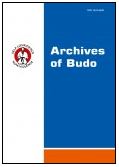2021, Volume 17
The ankle joint dorsiflexion range of motion in the closed kinematic chain of judokas and football players – pilot study
Dávid Líška1, Erika Liptaková2, Ladislav Baťalík3, Sebastian Rutkowski4
1Matej Bel University, Banská Bystrica, Slovak Republic
2Department of Applied Mathematics and Business Informatics, Faculty of Economics, Technical University of Košice, Slovakia , Kosice, Slovak Republic
3Department of Rehabilitation, University Hospital Brno, Czech Republic , Brno, Czech Republic
4Department of Physical Education and Physiotherapy, Opole University of Technology, Opole, Poland
Author for correspondence: Dávid Líška; Matej Bel University, Banská Bystrica, Slovak Republic; email: david.liska27@gmail.com
Full text
Abstract
Background and Study Aims: Judo is a sport that requires combination of multiple demanding training attributes. Little is known about the impact of a long-term practice on the ankle joint dorsiflexion range of motion. The aims of this pilot study is knowledge about dorsiflexion range of motion in the judokas in comparison to the football players.
Material and Methods: The sample included 20 judokas with a mean age of 20.15 years (±4.17). The mean weight of the judokas was 82.15 kg (±15.5). The mean height of the judokas was 180.40 cm (±7.46). The control group consisted of 22 football players with a mean age of 21.63 (±3.40). The mean weight of the football players was 75.90 kg (±6.67). The mean height of the football players was 181.27 cm (±5.86).
Results: The mean right ankle joint dorsiflexion range of motion in judokas was 43.15° ( ±6.71). The mean right ankle joint dorsiflexion range of motion in football players was 41.02° (±5.72). The mean left ankle joint dorsiflexion range of motion in judokas was 43.90° (SD ± 6.68). The mean left ankle joint dorsiflexion range of motion in football players was 42.09° ( ±7.17). Non-significant difference was finding between groups in right (p = 0.357) or left (p = 0.284) ankle joint dorsiflexion range of motion.
Conclusion: Greater ankle joint dorsiflexion range of motion was finding in judokas. Better adaptation in favor of the judokas means greater variability in the movement of the ankle towards the dorsiflexion in the judoist training process. Judo leads to better adaptation in the ankle joint towards dorsiflexion in ankle joint in compared to football players. However, result was no statistically significance.
Key words: judo, weight bearing lunge test, dorsiflexion, adaptation




